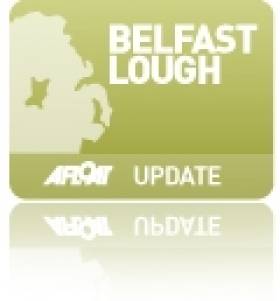Displaying items by tag: Loch Ryan Port Cairnryan
#BELFAST HARBOUR -The largest port in the north reported improved turnover and profit during 2010-2011, according to the annual report of Belfast Harbour.
The port showed a 2% rise in profit before taxation to £17.8m and a 4% increase in turnover to £36.1m. Underpinning the harbour's performance were record levels of tonnages handled during the period - up 7% to 17.6m tonnes. Although some sectors, such as those related to construction, continued to struggle, this was offset by growth elsewhere.
The number of freight vehicles passing through the port rose by 14% to 357,000 and a record four million tonnes were handled in the dry-bulk sector, which includes trades such as aggregates and coal.
Belfast Harbour noted that capital expenditure projects valued at £18.3m were completed during 2010-11. A further £53.8m was committed to additional projects at the year end, principally the development of the UK's first dedicated offshore wind logistics terminal for DONG Energy.
Len O'Hagan, Belfast Harbour's Chairman, said: "In spite of ongoing sluggishness in both the UK and Irish economies, Belfast Harbour has posted a very strong set of results for 2011, reflecting the diverse nature of the business and a long-term strategy of major capital investment to ensure that Belfast offers the most modern maritime facilities on the island.
"Significant uncertainty, however, still exists in the global economy, with the UK officially falling back into recession and the continuing eurozone crisis which is undermining business confidence throughout the continent and beyond.
"There are still opportunities for growth, though, particularly in renewable energy where Belfast Harbour is investing £50m in a new terminal for the assembly of offshore wind turbines. There have also been opportunities to further develop Belfast Harbour Estate, not least the Titanic Belfast visitor attraction, which received a £13.6m donation from Belfast Harbour, and the Northern Ireland Science Park which was the subject of a £6m investment by the Harbour to facilitate a 55,000 sq ft expansion."
During the year the port benefitted from several developments within the Irish Sea ferry sector, including the opening of Stena Line's new Scottish terminal at Loch Ryan Port (Cairnryan) and introduction of a pair of larger and more modern vessels. During this timeframe Stena Line had completed its takeover of DFDS Seaways Belfast - Birkenhead route and freight-only service to Heysham.
Mr O'Hagan added: "Although the overall performance of Belfast Harbour has been strong, it is clear that economic recovery across the UK and Ireland remains patchy. Belfast Harbour, however, is committed to its long-term strategy of investing in infrastructure to maintain the Port's competitiveness and provide much needed capital projects for the construction industry."
Second Stena ‘Superfast’ Ferry is Underway from Poland
The new route to Loch Ryan Port, Cairnryan includes a new £80m ferryport terminal which will be served by the 30,000 gross tonnes sisters, the largest ever ferries on the North Channel. Stena Superfast VIII is currently in the Skagerrak off northern Denmark and follows her sister Stena Superfast VII which arrived over the weekend, having also undergone refurbishment at the Romentowa shipyard.
The relocation of Scottish terminal from Stranraer to Loch Ryan Port is seven miles closer to the open sea and sailing times are to be reduced to 2hrs and 15minutes. The new terminal is to be officially opened on 25th November when First Minister of Scotland Alex Salmond and Deputy First Minister of Northern Ireland Martin McGuinness will join Dan Sten Olsson, Chairman of Stena Line.
As for the 15,229 gross tonnes Stena Navigator, she made her Stranraer-Belfast sailing yesterday, after de-storing at the VT4 ferry terminal, only completed in 2008, she proceeded to berth at Albert Quay, the location of the former city-centre ferry terminal.
In the interim period to the opening of the new Belfast-Cairnryan route, the sailing schedule on the Belfast-Stranraer service are been maintained by another conventional ferry, Stena Caledonia and fast sailings by the HSS Stena Voyager.
HSS Stena Voyager is expected to lay-up at VT4 after making final sailings to and from Stranraer this Sunday. It is expected Stena Caledonia will also be withdrawn that day and berth at Albert Quay. In the process she will pass Harland & Wolf shipyard, where she was launched in 1981 as the St. David, the last of the quartet of Saint-class ferries commissioend for Sealink/British Rail.
The career of Stena Navigator on the North Channel was short as she only entered service two years ago. She was built in 1984 as Champs Elysees first served for SNCF/Sealink's jointly run Dover-Calais route, followed by a brief spell under Stena Line as Stena Parisien on Newhaven-Dieppe sailings.
She returned to the Straits of Dover route but this time as SeaFrance Manet under the control of SeaFrance. In 2008 SeaFrance introduced SeaFrance Moliere, the former Superfast X, ironically another sister of Stena Line's 'Superfast' ships. This Superfast vessel along with two custom built newbuilds entered SeaFrance service in recent years which led to the eventual replacement of SeaFrance Renoir and her half sister SeaFrance Manet.
- Port of Belfast
- Stena Line
- Ports and Shipping News
- Ferry news
- Loch Ryan Port
- HSS Stena Voyager
- St. David
- SeaFrance
- DoverCalais
- Belfast Lough News
- Sealink
- H&W
- BelfastCairnryan
- Stena Superfast sisters
- Loch Ryan Port Cairnryan
- Romentowa
- Harland & Wolf
- Sealink/British Rail
- SaintClass sisters
- SNCF
- Straits of Dover
- Attica
- VT4 Terminal
- Loch Ryan Scotland
- Sealink British Rail
























